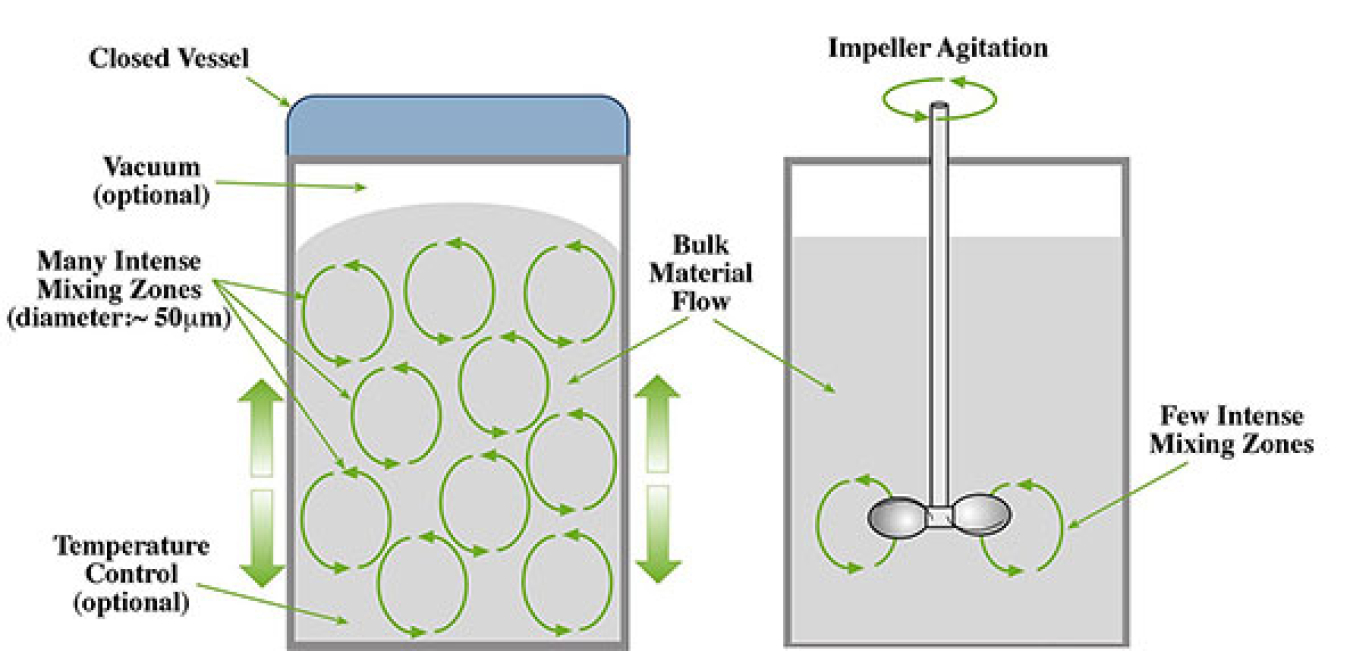New Acoustic Mixing Technology Improves Productivity Using Low-Frequency, High-Intensity Sound Energy
Typical mixing technology uses a drive mechanism—usually an electric, hydraulic, or pneumatic motor—to rotate a shaft with one or more impellers. While many other mixer designs are available, including static mixers that do not use motors, the motor-driven mixer is the most prevalent mixing method.
Resodyn Corp.'s ResonantAcoustics® mixing (RAM) technology, developed with the aid of a grant from DOE's Inventions and Innovation Program, is an improved approach to solving mixing and dispersion problems associated with conventional impeller agitation and ultrasonic mixing. Rather than mix by inducing bulk fluid flow, such as impeller agitation, RAM agitation mixes by inducing microscale turbulence through propagating acoustic waves throughout the medium. The RAM system has a lower frequency of acoustic energy and larger scale of mixing than ultrasonic agitation. Another distinct difference from ultrasonic technology is that the RAM devices are simple, mechanically driven agitators that can be made large enough to perform industrial-scale tasks at reasonable cost.
RAM introduces acoustic vibrations into liquids and slurries via the resonant vibration of a mechanical system. The impedance of the vibrating system is matched to that of the load, i.e., the process fluid. The entire system vibrates in resonance, which allows efficient energy transport to the fluid, creating small-scale eddies. Although the eddies are microscale, the entire reactor is well-mixed in an extremely short time because the acoustic streaming, generated by the acoustic field, causes the microscale vortices to be distributed uniformly throughout the fluid. Multiple mixing regimes are possible by using the RAM system and the controls developed exclusively for it.
Since the commercialization of the technology, Resodyn has sold tens of laboratory-scale mixers to both U.S. and international customers and has extended the product line by adding 5-gallon and 55-gallon capacity mixers for production applications. Industries that use mixers in their production process are extremely receptive to new mixing technologies that could help improve efficiency and lower their manufacturing costs.

Resonant/Acoustics® Mixing vs. Impeller Mixing
OVERVIEW
- Developed by Montec Research Inc.
- Commercialized in 2007
- Marketed by Resodyn Acoustic Mixers Inc.
APPLICATIONS
Can be used in a number of industries, including ceramics, biotechnology, agriculture, chemical manufacturing and processing, food, mining, municipal waste treatment, petroleum, pharmaceutical, pulp and paper, aerospace, microelectronics, and water treatment.
CAPABILITIES
- Uses acoustic energy rather than impellers to mix gases, liquids, and slurries.
- Mixes a wide viscosity range (1cP to 100+million cP).
- Can mix in a shipping container using a LabRAM 500 ml mixer.
BENEFITS
Productivity
Integrates into complete gas handling, sampling, and computing systems with a compact, robust design.
Profitability
Enhances mass transport and improves reaction rates on both macro- and micromixing levels. Can easily tune to different frequencies, making them suitable for multiple applications, such as heat- or mass-transfer limited systems, those that expend inordinate mixing energy, or those that require mixing uniformity.
Profitability
Reduces mixing time up to 62% and competes with current mixer prices in many applications.
CONTACT INFORMATION
Scott Leap
(406) 497-5255
scott.leap@resodyn.com
Resodyn Corp.

